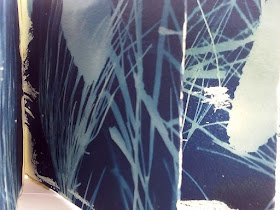Its the Desert Oak, from Central Australia. Its latin name is Allocasuarina decaisneana and its a slow growing tree with the typical branchlets of the casuarina family.
Young trees have a narrow trunk and form, looking somewhat like old-fashioned feather dusters. They mature to an adult form with spreading limbs and bushy foliage.
They tend to grow in multiples in the one area which creates a surreal looking landscape of the variously shaped trees in different growth stages.
During my recent trip to Curtin Springs Cattle Station, I decided to produce a work based on these trees. When I visited in 2018, I did sketches of the trees, their branchlets and their cones. This time I wanted to extend myself a bit more, and decided to use cyanotypes to record the trees.
Using my unit's bathroom, I created a darkroom to pre-coat my papers with the cyanotype solution, then exposed them the next day with various samples I had collected. The sunlight was very strong, so I couldn't use my standard exposure times, but chose instead to work fairly organically and probably did overexpose the prints. I love the serendipity of it anyway.
I've assembled the cyanotype prints into a concertina book, using a piece of my handmade paper I created from the station's grasses. The cover features a sample of paper made from the Desert Oak.
We have casuarinas here on the coast, known as She-Oaks, but the Desert Oaks have really captured my imagination, so I've enjoyed creating this book to record my memories of them.
 |
| Recording Desert Oaks in my sketchbook in 2018. |
 |
| Young Desert Oaks - they look like feather dusters I think! |
 |
| Mature Desert Oaks, surrounded by a few young ones. I can still hear the wind whispering through the branchlets. |
 |
| The front cover of my book, featuring Desert Oak paper and cyanotype of the branchlets. |
 |
| You can see the texture of the paper in this photo...yum! |
 |
| This photo shows the spine of handmade paper. The earthy colour of paper sits well with the indigo of the cyanotypes. |



















